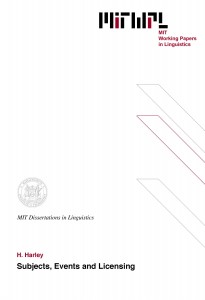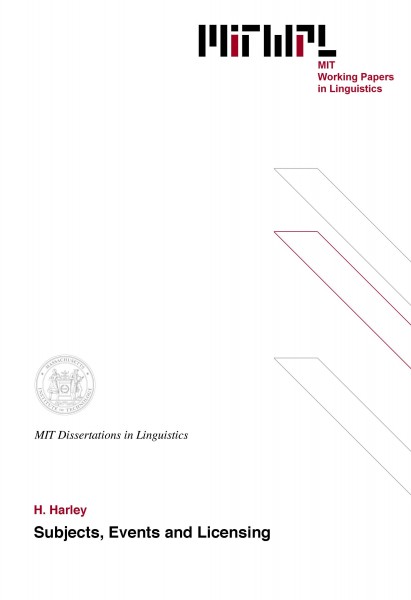Subjects, Events and Licensing
H. Harley, 1995
While the notion of “subject” as a primitive of grammar is in some way encoded in most modern syntactic theories, the cluster of syntactic properties attributed to subjects is not a homogenous one. This thesis aims to precisely characterize certain of these properties, partially through an investigation of constructions where they fail to converge.
Two of these properties are of particular interest. First, the structural properties associated with “external arguments” are examined, that is, the question of where thematic subjects (as opposed to clausal subjects) are base generated. Drawing on evidence from Japanese lexical causatives, a “split VP” structure is argued for, in which external arguments (Agents, Causers) are generated in the specifier of a projection which marks the introduction of an event argument (hence termed EventP). Below EventP are case-checking positions for underlying objects and indirect objects (internal arguments) as well as the projection in which internal arguments are base-generated (“BaseP”). “Verbs” on this approach consist of a “Base” head in combination with an “Event” head, and the decomposition of verbal meaning into “primitives” such as CAUSE, HAVE, or BE is assumed. In support, a correlation is drawn between the existence of the predicate “have” in a language and the possibility of a double object/double complement alternation, adducing evidence from Irish, Tagalog and Dine, as well as Japanese, Georgian and English.
Secondly, the question of morphological nominative case is considered. Nominative marking on an NP is typically taken to be an indicator of subjecthood, nonetheless, there are constructions in which a nominative-marked argument appears to be in object position. Such nominative objects in Icelandic are examined in detail, and a mechanism for assigning morphological case is proposed which modifies standard assumptions about the struct connection of morphological case with structure position. Given such modification, the question of NP-licensing is re-examined, with an eye to dispensing with abstract case entirely; the apparent effects of abstract case assignment (and, incidentally, Burzio’s Generalization) are seen to be the result of the interaction of the mechanism governing morphological case assignment with the Extended Projection Principle.
Thesis Supervisor: Alec P. Marantz
Title: Professor of Linguistics
<br/>
Table of Contents
Chapter 1 Subject 13
1.1 A syntactic “subject” position: agents vs. “subjects” 15
1.2 “Subject: property mismatches 18
1.3 Conclusion 23
Part I Projection 25
Chapter 2 Where don’t they come from? 27
2.1 Against subjects in Spec-IP 28
2.1.1 Conjunction of activities and passives 28
2.1.2 The behavior of modals: I0 as a raising category 31
2.1.3 Reconstruction effects 32
2.1.4 VSO order: against the Spec-IP generation of subjects 33
2.1.4.1 Excursus: Old Irish and the ISH 36
2.1.4.1.1 The Old Irish verbal system 37
2.1.4.1.2 Verb movement to Io and Co 38
2.1.4.1.3 Preverbs 39
2.1.4.1.4 Object enclitics 42
2.1.4.1.5 Subjects in Spec-IP 43
2.1.5 Conclusion 45
2.2 Subjects in expanded Infl 45
2.2.1 Tense and modals as raising categories 47
2.2.2 Subject trace in VP: Huang (1993) 48
2.2.3 Complement to causative “have” 49
2.2.4 Against generation in AgrOP 52
2.2.5 Conclusion 54
Chapter 3 VPs, l-syntax and external arguments 55
3.1 In support of stacked structures 56
3.1.1 Overt object movement and ECM: the adjacency condition 58
3.1.2 Overt object movement in simple clauses: the adjacency
condition 61
3.1.3 Quantifier float and the base position of objects in Japanese 69
3.1.4 Consequences of adopting stacked structures 70
3.1.4.1 Case positions and q-positions 71
3.1.4.2 Getting the external/internal distinction from the
syntax 72
3.1.4.3 External vs. internal VPs and adverb type: Bowers
(1993) 77
3.1.5 The story so far 81
3.2 Events, agents and verbs 83
3.2.1 L-syntax: deriving the lexicon 83
3.2.1.1 How many theta-roles? Hale and Keyser’s question 83
3.2.1.2 VoiceP, unaccusatives and agents 86
3.2.1.3 “Kill” as “cause to die”: event structure 87
3.2.2 Lexical Japanese causatives: l-syntax and Late Insertion 89
3.2.2.1 “Lexical” vs. “analytic”: interpreting V+sase 90
3.2.2.2 The “elsewhere” rule: Late Insertion 92
3.2.2.3 Lexical causatives: realizing CAUSE 96
3.2.2.3.1 More evidence for Late Insertion 100
3.2.3 EventP as a delimiter: why non-compositional
interpretation? 101
3.2.4 Properties of EventP 102
3.2.4.1 “Primitives”: A, N, P 102
3.2.4.2 The “syntax” of l-syntax 104
3.2.5 “Give”= Cause x Have y 106
3.2.5.1 The preposition HAVE 107
3.2.5.2 “Have” = BE + HAVE 108
3.2.5.3 Existentials, possessives and locatives: Freeze
(1992) 111
3.2.5.4 Definiteness vs. HAVE 113
3.2.5.5 Languages without HAVE 115
3.2.5.5.1 Irish 115
3.2.5.5.2 Dine 117
3.2.5.5.3 Tagalog 119
3.2.5.6 Languages with HAVE 122
3.2.5.6.1 English 122
3.2.5.6.2 Japanese 122
3.2.5.6.3 Georgian 125
3.2.6 Some implications 126
3.2.6.1 Auxiliaries 126
3.2.6.2 Causative and experiencer have 128
3.2.6.3 Other possible complements of EventP: CP, TP 131
3.2.6.4 VP adverbials revisited 132
3.2.7 Conclusion 133
Part II Licensing 135
Chapter 4 Realizing case 137
4.1 Case theory 138
4.1.1 Case and the VP-internal subject hypothesis 141
4.1.2 An Agr-based case theory 142
4.2 The case of the Icelandic experiencer 143
4.2.1 Dative-nominative experiencer subject constructions 143
4.2.2 Case in experiencer subject constructions 144
4.2.3 Structural nominative 145
4.2.4 Nominative in To? 147
4.2.4.1 Negative polarity items 147
4.2.4.2 Finiteness and tense 148
4.2.5 The mechanics of case 150
4.3 Japanese causatives 152
4.3.1 The problem 154
4.3.1.1 Case alternations and the make/let distinction 154
4.3.2 “Make” vs. “Let” readings: syntactic facts 156
4.3.2.1 Biclausal –sase- 156
4.3.2.2 Passivization of “make” vs. “let” 157
4.3.2.3 Construal of “agent-oriented” adverbs 157
4.3.3 The analysis, part I: clause-bound case-marking 158
4.3.3.1 Prepositional vs. case-marking –ni 160
4.3.3.2 The MCP and the “make” causative 161
4.3.4 The analysis, part II: syntactic differences 162
4.3.4.1 The “let” causative: scope facts 165
4.3.4.2 The “agent-oriented” adverbs 165
4.3.5 Causee as matrix object 167
4.3.5.1 V+cause – syntactic or morphological? Terada 167
4.3.5.2 Passive and causative 169
4.3.6 Scope of the causee: “make” causative 170
4.4 Conclusion: realization of case recap 171
Chapter 5 Case, the EPP, and having experiences 173
5.1 Burzio’s Generalization and the EPP 174
5.1.1 Does Burzio’s Generalization exist? 174
5.1.2 Case-assignment: no abstract case required 177
5.1.2.1 ECM and PRO: activating Agr 178
5.2 Movement restrictions: equidistance and leapfrogging 180
5.2.1 Holmberg’s generalization 181
5.2.2 OS for case? 182
5.2.3 TEC+OS and dative-nominative constructions 183
5.2.4 A split-VP and equidistance 187
5.3 PRO and the EPP 189
5.3.1 Control vs. ECM revisited 189
5.3.2 Irish and the EPP 192
5.4 Auxiliaries, undercover agents, and other psychological problems 193
5.4.1 Mandatory agents and transitive verbs 194
5.4.2 Implicit agents and causative and auxiliary HAVE 196
5.4.3 HAVE and dative-nominative constructions diachronically 199
5.4.3.1 Irish psychological predicates 201
5.4.3.2 Psych predicaates in other HAVEless languages 202
5.4.3.2.1 Dine: “subject-verb idioms” 203
5.4.3.2.2 Tagalog: a psychological problem 204
5.4.3.3 Getting HAVE 206
5.4.3.4 Incorporation and psych predicates 208
5.5 Conclusion 210
Appendix to Chapter 5 Dative-nominative constructions 211
A.1 Icelandic 212
A.2 Japanese 215
A.3 Kannada 218
Chapter 6 Concluding Remarks 221

